Roofers face many hazards, including those associated with working at heights, ladders, using power tools, noise, toxic substances and even extreme temperatures
Before we dive into the costs of injuries, the most common types of injuries on construction sites, and some compelling statistics about their cost, let’s first look at the risks typically associated with roofing.
Falls from heights are a serious problem in the roofing industry.
In particular, falls from roofs accounted for a third of deaths during this period.
Falls from heights are also a leading cause of injury. In fact, according to the Occupational Safety and Health Administration (OSHA), the most common violations in the construction industry are those related to fall prevention. Not surprisingly, the risk of serious injury and death from falls increases significantly as the height increases. That said, falls from low heights are also a risk. Roofers can suffer a variety of injuries, including fractures, spinal cord injuries, concussions, and brain injuries.
In Canada, the Ontario Minister of Labour has identified the hazards that cause the most frequent workplace accidents on low-rise residential construction sites*. Here they are:
Falls are more common in small businesses.
According to statistics from the Center for Construction Research and Training (CPWR), falls occurring in companies employing 10 people or less account for 54% of all fatal falls (in companies and larger companies, this rate varies between 9% and 16%).
Why such a gap? It is generally accepted that small businesses do not have the financial resources or do not invest as effectively in security measures as larger companies.
However, as we will see, it is clearly beneficial for a business to create a safe workplace. This is especially true for a small business, where the costs associated with an injured employee have a greater impact.
Obviously, the most significant impact of an injury is the human cost to the affected employee. An injury can cause enormous emotional and financial hardship for the employee and their family.
Workplace illnesses and injuries can also significantly affect your profit margin, considering their direct and indirect costs.
Direct costs include workers’ compensation, medical expenses and legal service costs.
Work accident compensation is used to compensate for medical, pharmaceutical and convalescence costs not covered by the health system.
If the workplace illness or injury involves defective or missing safety equipment, you will need to repair, replace or install the appropriate equipment.
If it is the employee who failed to comply with safety regulations, the employer will have to pay the cost of legal proceedings and any fines imposed by the court.
In most states, roofing ranks as the highest-risk occupation. According to the U.S. Bureau of Labor Statistics, workers’ compensation costs are higher in natural resources, construction, and maintenance than in any other type of job.
Indirect costs are less obvious, although in reality they can exceed direct costs. Indirect costs include:
In an industry where finding and retaining good employees is a daily challenge, demonstrating your commitment to worker safety can help you stand out as an employer.
The cost of workplace accidents can be calculated in several ways.
Here are some statistics that caught our attention regarding the cost of workplace accidents (all from the US Bureau of Labor):
In March 2015, employers in the natural resources, construction and maintenance sectors paid an average of $1.02/hour worked in compensation, compared to $0.45 for all other sectors.
Workplace injury benefits account for nearly 3% of all benefits paid in this sector, compared to 1.4% for all other sectors.
Among insured roofers, costs related to falls from heights reached $54 million per year from 2005 to 2007 (the most recent period for which statistics are compiled), according to the National Council on Compensation Insurance .
For a roofing contractor, the average cost of a fall from height is about $106,000 per injured employee, according to OSHA (compared to less than $50,000 for a fall from height in other industries).
A roofer alone accidentally falling off a ladder or stepladder costs approximately $68,000 (OSHA).
Although the extent of direct costs depends on your insurance policy coverage, indirect costs are always paid by you.
Workplace accidents can affect every aspect of your business—from employee loyalty to your bottom line. That’s why preventing workplace accidents is a smart, profitable investment
Calculate the potential costs associated with an accident at work involving one of your employees.
To assess the direct and indirect costs of different types of workplace injuries, and the impact they can have on your bottom line, OSHA has created an online estimator tool.
We used this tool to assess the fictitious case of an employee who suffered a fracture at work. We obtained the following results:
Prevention is essential to the health of your workforce — and your finances.
We cannot end the discussion on workplace accidents without mentioning how roofing contractors can create a safe work environment for their employees. Remember that the vast majority of roofing accidents can be prevented with proper planning, proper training and adequate safety equipment.
Personal Protective Equipment
Working on a roof is similar to working on a construction site, so safety helmets and steel-toed boots are essential. In addition, hot bitumen is a significant hazard near a tar boiler. To avoid burns, it is necessary to wear a safety visor and suitable protective gloves.

